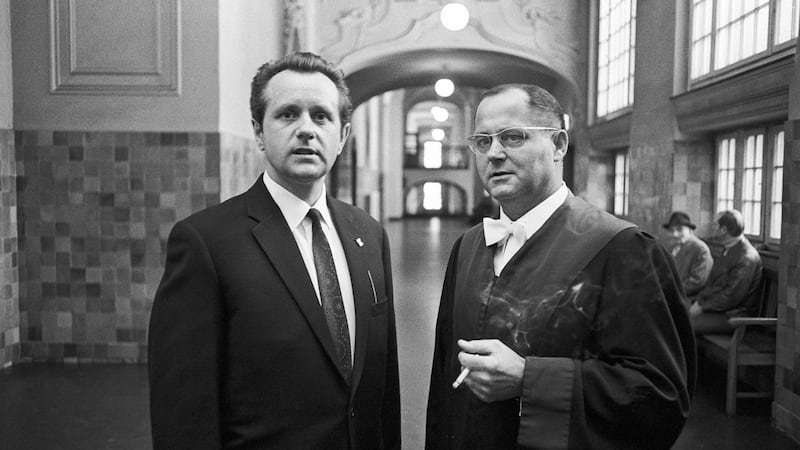Half a century on, Germany is still arguing over why he had to die. Opposite the Deutsche Oper in western Berlin, it’s easy to find the spot where Benno Ohnesorg was shot dead. It was in the the courtyard of the postwar building with the address Krummestrasse 66 that the Berlin student took a bullet at close range and bled to death.
The 26-year-old left behind a girlfriend, pregnant with a son he would never know. And although he was a nobody beforehand, after his death Ohnesorg became a household name. His shooting radicalised his fellow student generation against the conservative, reactionary West German establishment. Suddenly, abstract fears that the state was sliding back into old, authoritarian habits were, after June 2nd, 1967, very concrete.
The student movement that emerged after the shooting eventually brought two other organisations: a splinter group that became the Red Army Faction behind a left-wing terrorist rampage a decade later; others from that time found themselves in what later became the Green Party.
So why did Ohnesorg have to die? It all happened during the state visit of Mohammad Reza Pahlavi, the shah of Iran, with his wife, Soraya. The couple were the toast of West Germany’s tabloid press, but young left-wingers were furious the state was courting a regime dubbed, in one book, a “dictatorship in the free world”.
Hurling tomatoes
Opposite the Deutsche Oper, where the couple were to attend a production of Mozart's Magic Flute, about 500 Berlin students had gathered to hurl tomatoes and eggs at the convoy. Such protests embarrassed the West Berlin government and Bonn, which hoped a smooth visit would prevent Iran, then one of West Germany's few allies in the Middle East, sliding into Moscow's sphere of influence.
For leftist groups the emergency regulations were the final proof that West Germany was on a slippery slope back into authoritarianism
Three months earlier Bonn had passed new laws allowing for tougher police crackdowns in exceptional circumstances, and the shah’s visit was the first test. For leftist groups, in particular Berlin’s radical student groups, the emergency regulations were the final proof that West Germany was on a slippery slope back into authoritarianism.
Berlin mayor Heinrich Albertz, on his way into the opera with the shah, warned the police officers on duty: “When I come out, all this will be cleared up.” As the lights dimmed inside, the mood darkened outside and a student protest descended into a full-on riot. The students, beaten and dragged away by baton-wielding police, responded by throwing stones.
One police officer, hit by a stone in the head, ran screaming and bloodied from the scene; his colleagues heard a rumour that another officer had been stabbed. “I was in a panic even before I knew what had happened,” said Jenny Schon, one of the students on the streets that fateful evening.
Self-defence claim
Ohnesorg, an arts student at his first demonstration, fled with others into a side street, the Krummestrasse, and took refuge in the courtyard of No 66. There he was later joined by a plain-clothes police officer, Karl-Heinz Kurras, and a shot rang out. Questioned later by his colleagues, Kurras claimed he shot Ohnesorg in the head in self-defence. The young man collapsed on the ground and was immediately unresponsive.
Press photographers rushed to the scene and took pictures of a young woman comforting Ohnesorg while, over her shoulder, yelling for help that came too late. Ohnesorg died at the scene, in a pool of his own blood. A full autopsy and ballistics tests were not possible because the gun used in the shooting vanished, as did parts of Ohnesorg’s shattered skull.

Exactly 50 years later Ohnesorg’s family is still haunted by the killing. Lukas, his son, said: “I want this to be investigated again, things to be put right and that I get compensation.”
It may be too late to put things right, but not too late to put things straight. Hans Brombosch was looking out the courtyard window of his parent’s ground-floor apartment when he saw Ohnesorg come in.
Brombosch had seen everything, but his testimony was discounted by the court as he was only eight at the time
“He stood there for a good long while, and it was when he went to leave that it happened,” remembers Brombosch. “That was the moment when I saw the person with the pistol. He was standing alone, with no one in the vicinity who could have threatened him.”
Though Brombosch had seen everything, his testimony was discounted by the court as he was only eight at the time. Kurras went on trial – twice – and walked free.
Five years before his death in 2014, it emerged that he was on the payroll of East Germany’s Stasi. There is no proof that the shooting of Ohnesorg was an order from East Berlin, but just one bullet changed the course of German history.





















